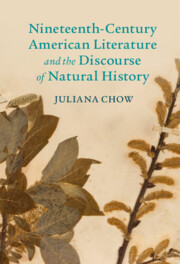Book contents
- Nineteenth-Century American Literature and the Discourse of Natural History
- Cambridge Studies in American Literature and Culture
- Nineteenth-Century American Literature and the Discourse of Natural History
- Copyright page
- Contents
- Figures
- Acknowledgments
- Introduction
- Chapter 1 Sketching American Species: Birds, Weeds, and Trees in Audubon, Cooper, and Pokagon
- Chapter 2 “Because I see—New Englandly—”: Emily Dickinson and the Specificity of Disjunction
- Chapter 3 Coral of Life: James McCune Smith and the Diasporic Structure of Racial Uplift
- Chapter 4 Thoreau’s Dispersion: Writing a Natural History of Casualties
- Afterword: &
- Notes
- Index
- Recent Books in This Series (continued from page ii)
Chapter 1 - Sketching American Species: Birds, Weeds, and Trees in Audubon, Cooper, and Pokagon
Published online by Cambridge University Press: 16 November 2021
- Nineteenth-Century American Literature and the Discourse of Natural History
- Cambridge Studies in American Literature and Culture
- Nineteenth-Century American Literature and the Discourse of Natural History
- Copyright page
- Contents
- Figures
- Acknowledgments
- Introduction
- Chapter 1 Sketching American Species: Birds, Weeds, and Trees in Audubon, Cooper, and Pokagon
- Chapter 2 “Because I see—New Englandly—”: Emily Dickinson and the Specificity of Disjunction
- Chapter 3 Coral of Life: James McCune Smith and the Diasporic Structure of Racial Uplift
- Chapter 4 Thoreau’s Dispersion: Writing a Natural History of Casualties
- Afterword: &
- Notes
- Index
- Recent Books in This Series (continued from page ii)
Summary
Chapter 1 explores how American settler colonialism in the nineteenth century utilized “nature” and the synonymous “native” in contradictory ways: celebrating the wilderness and then cutting it down, mourning lost “natives” (both people and species) while also seeing the succession of new Euro-American settlers as an expression of the natural order. The chapter traces the countervailing themes of “native” species in three sketch writers: John James Audubon, Susan Fenimore Cooper, and Simon Pokagon. Each one exposes an emergent sense of ecological relation that comes from their perception of being close to nature. Contextualizing these sketches within the American picturesque tradition as well as other popular visual technologies of the time, the chapter examines how what is called their “species of seeing” hews to both Enlightenment traditions of objectivity while also skewing toward more aesthetic senses of mediation between the “native” artist-scientist and wild “other.” In their writings, it becomes possible for the sketch to become an apparatus for constituting “species” as more mutable entities. Various species, whether the swallow, the passenger pigeon, or even the Native American, become figures through which biological life becomes understood as dispersed into its geographical migrations.
Keywords
- Type
- Chapter
- Information
- Publisher: Cambridge University PressPrint publication year: 2021



